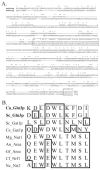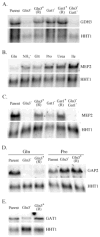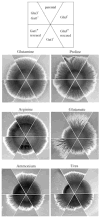GLN3 encodes a global regulator of nitrogen metabolism and virulence of C. albicans
- PMID: 17950010
- PMCID: PMC2683589
- DOI: 10.1016/j.fgb.2007.08.006
GLN3 encodes a global regulator of nitrogen metabolism and virulence of C. albicans
Abstract
The function of GLN3, a GATA factor encoding gene, in nitrogen metabolism of Candida albicans was examined. GLN3 null mutants had reduced growth rates on multiple nitrogen sources. More severe growth defects were observed in mutants lacking both GLN3 and GAT1, a second GATA factor gene. GLN3 was an activator of two genes involved in ammonium assimilation, GDH3, encoding NADP-dependent glutamate dehydrogenase, and MEP2, which encodes an ammonium permease. GAT1 contributed to MEP2 expression, but not that of GDH3. A putative general amino acid permease gene, GAP2, was also activated by both GLN3 and GAT1, but activation by GLN3 was nitrogen source dependent. GLN3 was constitutively expressed, but GAT1 expression varied with nitrogen source and was reduced 2- to 3-fold in gln3 mutants. Both gln3 and gat1 mutants exhibited reduced sensitivity to rapamycin, suggesting they function downstream of TOR kinase. Hyphae formation by gln3 and gat1 mutants differed in relation to nitrogen source. The gln3 mutants formed hyphae on several nitrogen sources, but not ammonium or urea, suggesting a defect in ammonium assimilation. Virulence of gln3 mutants was reduced in a murine model of disseminated disease. We conclude that GLN3 has a broad role in nitrogen metabolism, partially overlapping, but distinct from that of GAT1, and that its function is important for the ability of C. albicans to survive within the host environment.
Figures






Similar articles
-
Control of ammonium permease expression and filamentous growth by the GATA transcription factors GLN3 and GAT1 in Candida albicans.Eukaryot Cell. 2007 May;6(5):875-88. doi: 10.1128/EC.00307-06. Epub 2007 Mar 16. Eukaryot Cell. 2007. PMID: 17369441 Free PMC article.
-
Nitrogen regulation of morphogenesis and protease secretion in Candida albicans.Int J Med Microbiol. 2011 Jun;301(5):390-4. doi: 10.1016/j.ijmm.2011.04.005. Epub 2011 May 8. Int J Med Microbiol. 2011. PMID: 21555241 Review.
-
Nitrogen metabolism and virulence of Candida albicans require the GATA-type transcriptional activator encoded by GAT1.Mol Microbiol. 2003 Nov;50(3):993-1004. doi: 10.1046/j.1365-2958.2003.03747.x. Mol Microbiol. 2003. PMID: 14617156
-
Tor pathway control of the nitrogen-responsive DAL5 gene bifurcates at the level of Gln3 and Gat1 regulation in Saccharomyces cerevisiae.J Biol Chem. 2008 Apr 4;283(14):8919-29. doi: 10.1074/jbc.M708811200. Epub 2008 Feb 1. J Biol Chem. 2008. PMID: 18245087 Free PMC article.
-
Transmitting the signal of excess nitrogen in Saccharomyces cerevisiae from the Tor proteins to the GATA factors: connecting the dots.FEMS Microbiol Rev. 2002 Aug;26(3):223-38. doi: 10.1111/j.1574-6976.2002.tb00612.x. FEMS Microbiol Rev. 2002. PMID: 12165425 Free PMC article. Review.
Cited by
-
Recent advances in nitrogen regulation: a comparison between Saccharomyces cerevisiae and filamentous fungi.Eukaryot Cell. 2008 Jun;7(6):917-25. doi: 10.1128/EC.00076-08. Epub 2008 Apr 25. Eukaryot Cell. 2008. PMID: 18441120 Free PMC article. Review. No abstract available.
-
Diverse Hap43-independent functions of the Candida albicans CCAAT-binding complex.Eukaryot Cell. 2013 Jun;12(6):804-15. doi: 10.1128/EC.00014-13. Epub 2013 Mar 29. Eukaryot Cell. 2013. PMID: 23543673 Free PMC article.
-
Ribosomal protein S6 phosphorylation is controlled by TOR and modulated by PKA in Candida albicans.Mol Microbiol. 2015 Oct;98(2):384-402. doi: 10.1111/mmi.13130. Epub 2015 Aug 22. Mol Microbiol. 2015. PMID: 26173379 Free PMC article.
-
Overview of carbon and nitrogen catabolite metabolism in the virulence of human pathogenic fungi.Mol Microbiol. 2018 Feb;107(3):277-297. doi: 10.1111/mmi.13887. Epub 2017 Dec 29. Mol Microbiol. 2018. PMID: 29197127 Free PMC article. Review.
-
Glutamate dehydrogenase (Gdh2)-dependent alkalization is dispensable for escape from macrophages and virulence of Candida albicans.PLoS Pathog. 2020 Sep 16;16(9):e1008328. doi: 10.1371/journal.ppat.1008328. eCollection 2020 Sep. PLoS Pathog. 2020. PMID: 32936835 Free PMC article.
References
-
- Beck T, Hall MN. The TOR signalling pathway controls nuclear localization of nutrient- regulated transcription factors. Nature. 1999;402:689–692. - PubMed
-
- Bertram PG, et al. Tripartite regulation of Gln3p by TOR, Ure2p, and phosphatases. J Biol Chem. 2000;275:35727–33. - PubMed
-
- Biswas K, Morschhauser J. The Mep2p ammonium permease controls nitrogen starvation-induced filamentous growth in Candida albicans. Mol Microbiol. 2005;56:649–69. - PubMed
-
- Boeke JD, et al. A positive selection for mutants lacking orotidine-5′-phosphate decarboxylase activity in yeast: 5-fluoro-orotic acid resistance. Mol Gen Genet. 1984;197:345–346. - PubMed
Publication types
MeSH terms
Substances
Grants and funding
LinkOut - more resources
Full Text Sources
Molecular Biology Databases

